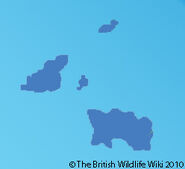The Lapwing, Vanellus vanellus has a very distinctive flight when the male is flying over and defending his territory. It will climb up just after take off, once it has reached the top of its climb, it will fall in a twisiting roll dive with an upward twist. This can be seen accompanied by rapid wing beats. The Lapwing is useful to farmers as it eats snails, slug

Lapwing, by Erik Paterson.
s, leather jackets and wireworms. It will nest in a dip in the ground and the female will lay 4 very pointy eggs that are olive in colour with heavy blotches. The chicks can run as soon as they have hatched. They can sometimes still have some shell stuck to them. During winter months, flocks of lapwings move south to Southern England and Southern Europe, and can often be seen with Golden Plover.
The Northern Lapwing (Vanellus vanellus), also known as the Peewit, Green Plover or (in the British Isles) just Lapwing, is a bird in the plover family. It is common through temperate Eurasia. It is highly migratory over most of its extensive range, wintering further south as far as north Africa, northern India, Pakistan, and parts of China. It migrates mainly by day, often in large flocks. Lowland breeders in westernmost areas of Europe are resident. It occasionally is a vagrant to North America, especially after storms, as in the Canadian sightings after storms in December 1927 and in January 1966.
It is a wader which breeds on cultivated land and other short vegetation habitats. 3–4 eggs are laid in a ground scrape. The nest and young are defended noisily and aggressively against all intruders, up to and including horses and cattle.
In winter it forms huge flocks on open land, particularly arable land and mud-flats.
Profile[]
Size: 30 cm
Description: Green upper parts that have an iridescent sheen that are tinged with purple. White underparts and a chestnut coloured undertail. Long black crest, with a white face and black face patch.
This lapwing is a 28–31 cm long bird with a 67–72 cm wingspan, It has rounded wings and a crest. It is the shortest-legged of the lapwings. It is mainly black and white, but the back is tinted green. Females and young birds have narrower wings, and have less strongly-marked heads, but plumages are otherwise quite similar.
The name lapwing has been variously attributed to the "lapping" sound its wings make in flight, from the irregular progress in flight due to its large wings (OED derives this from an Old English word meaning "to totter"), or from its habit of drawing potential predators away from its nest by trailing a wing as if broken. Peewit describes the bird's shrill call. This is a vocal bird in the breeding season, with constant calling as the crazed tumbling display flight is performed by the male.
It feeds primarily on mainly insects and other small invertebrates. This species often feeds in mixed flocks with Golden Plovers and Black-headed Gulls, the latter often robbing the two plovers, but providing a degree of protection against predators.
Like the Golden Plovers, this species prefers to feed at night when there are moonlit nights.
The Northern Lapwing is one of the species to which the Agreement on the Conservation of African-Eurasian Migratory Waterbirds (AEWA) applies.
Habitat: Farmland, moorland, pasture, seashore, mudflats and marshes
Voice: 'Pee-wit' sound
Flight: Floppy revealing its black and white rounded wings
Alternative English names:
- Peewit (old English)
- Green Plover (old English)
- Northern Lapwing (international)
- Pyewipe (Lincolnshire)
Videos[]

Lapwing
By Snakes1000000


